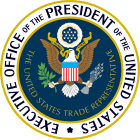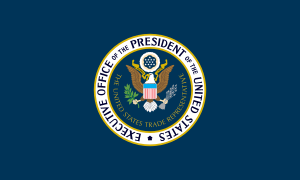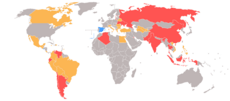Office of the United States Trade Representative facts for kids

Seal of the Office of the U.S. Trade Representative
|
|

Flag of the Office of the U.S. Trade Representative
|
|
| Agency overview | |
|---|---|
| Formed | 1962 |
| Preceding agency |
|
| Headquarters | Winder Building 600 17th St. NW Washington, D.C. |
| Employees | 200 |
| Annual budget | $73 million (FY 2021) |
| Agency executive |
|
| Parent agency | Executive Office of the President |
The Office of the United States Trade Representative (USTR) is a special agency that works for the U.S. government. Its main job is to create and promote trade policies for the United States with other countries.
USTR is part of the Executive Office of the President. It is led by the United States Trade Representative. This person is a top advisor to the U.S. President on all things related to trade. They also act as the main negotiator and spokesperson for the U.S. on trade issues. USTR has over 200 employees. They have offices in Geneva, Switzerland, and Brussels, Belgium.
USTR was first created in 1962. It was called the Office of the Special Trade Representative (STR) back then. This agency leads trade talks with other countries, both one-on-one and in larger groups. It also works with other government agencies to make sure trade policies are clear. USTR helps with things like foreign investments and protecting new ideas (intellectual property). They also help solve trade disagreements, especially at the World Trade Organization. The current United States Trade Representative is Katherine Tai.
Contents
What USTR Does
Leading the Office
The person in charge of USTR is called the United States Trade Representative (USTR). This is a very important job, almost like being in the President's main team, the Cabinet. However, it's not technically a Cabinet department.
To get this job, the President chooses someone. Then, the Senate must approve that person with a simple vote. The United States Trade Representative and their deputies are given the special title of ambassador.
Many people have held this important role. For example, Michael Froman was the U.S. Trade Representative from 2013 to 2017. Robert Lighthizer served during the presidency of Donald Trump. Katherine Tai has been serving during the presidency of Joe Biden.
Working with the World Trade Organization
The USTR plays a big part in the World Trade Organization (WTO). The WTO is a global group that sets rules for trade between countries. USTR's Office of WTO and Multilateral Affairs helps manage this work. They deal with agreements like the one about protecting intellectual property rights.
How USTR Started
Trade talks became much more complex in the 1900s. This was because of new global groups and faster ways to do business. The U.S. government needed a better way to handle trade. In 1962, Congress passed a law. It said the President should appoint a Special Representative for Trade Negotiations. This person would advise the President on trade.
In the 1970s, Congress gave this position more power. They made it a Cabinet-level job. Finally, in 1980, the position was renamed the United States Trade Representative. In 1988, a new law made the USTR's role even bigger. It said the USTR should lead trade policy, advise the President, and be the main spokesperson for U.S. trade talks. The USTR also had to report to both the President and Congress.
Areas USTR Works On
USTR works on many different trade topics. Here are some of them:
- Agriculture (farming products)
- Economy and trade rules
- Making sure trade rules are followed
- Environmental issues related to trade
- Government buying and selling
- Industry and manufacturing
- Protecting new ideas (intellectual property)
- Labor (worker rights)
- Special trade programs
- Services and investments
- Helping small businesses
- Textiles and clothing
- Trade and development for other countries
- Working with trade groups like the World Trade Organization (WTO), Asia-Pacific Economic Cooperation (APEC), Association of Southeast Asian Nations (ASEAN), and the Organization for Economic Co-operation and Development (OECD).
Important Reports
The National Trade Estimate
The National Trade Estimate Report on Foreign Trade Barriers is a report USTR puts out every year. It talks about big problems that stop U.S. products from being sold in other countries. Since 1986, this report has also tried to show how much these problems affect U.S. exports. It also shares what actions are being taken to fix these issues.
The Special 301 Report
The Special 301 Report is another yearly report from USTR. It identifies countries that do not properly protect intellectual property rights. This means they might not stop people from copying inventions, music, or movies without permission. The report also looks at countries that make it hard for U.S. companies to use their intellectual property fairly.
The report names "priority foreign countries." These are countries with the biggest problems in protecting intellectual property. They also have the largest negative impact on U.S. products. The report also checks if these countries are trying to fix the problems.
Notorious Markets
Since 2010, USTR has published a separate report called "Notorious Markets." This report lists places, often online, where a lot of copyright infringement happens. This means people are illegally copying and sharing things like movies, music, or software.
List of United States Trade Representatives
Denotes an acting U.S. trade representative
| # | Portrait | Name | Term Start | Term End | Duration | President(s) | |
|---|---|---|---|---|---|---|---|
| 1 |  |
Christian Herter | December 10, 1962 | December 30, 1966 | 4 years, 20 days | John F. Kennedy (1961–1963) |
|
| Lyndon Johnson (1963–1969) |
|||||||
| 2 |  |
William Roth | March 24, 1967 | January 20, 1969 | 1 year, 302 days | ||
| 3 |  |
Carl Gilbert | August 6, 1969 | September 21, 1971 | 2 years, 46 days | Richard Nixon (1969–1974) |
|
| 4 |  |
William Eberle | November 12, 1971 | December 24, 1974 | 3 years, 42 days | ||
| 5 |  |
Frederick Dent | March 26, 1975 | January 20, 1977 | 1 year, 300 days | Gerald Ford (1974–1977) |
|
| 6 |  |
Robert Strauss | March 30, 1977 | August 17, 1979 | 2 years, 140 days | Jimmy Carter (1977–1981) |
|
| 7 |  |
Reubin Askew | October 1, 1979 | December 31, 1980 | 1 year, 91 days | ||
| 8 |  |
Bill Brock | January 23, 1981 | April 29, 1985 | 4 years, 96 days | Ronald Reagan (1981–1989) |
|
| 9 |  |
Clayton Yeutter | July 1, 1985 | January 20, 1989 | 3 years, 203 days | ||
| 10 |  |
Carla Hills | February 6, 1989 | January 20, 1993 | 3 years, 349 days | George H. W. Bush (1989–1993) |
|
| 11 |  |
Mickey Kantor | January 22, 1993 | April 12, 1996 | 3 years, 81 days | Bill Clinton (1993–2001) |
|
| — |  |
Charlene Barshefsky | April 12, 1996 | March 18, 1997 | 4 years, 283 days | ||
| 12 | March 18, 1997 | January 20, 2001 | |||||
| 13 |  |
Robert Zoellick | February 7, 2001 | February 22, 2005 | 4 years, 15 days | George W. Bush (2001–2009) |
|
| — |  |
Peter Allgeier Acting |
February 23, 2005 | May 16, 2005 | 113 days | ||
| 14 |  |
Rob Portman | May 17, 2005 | May 29, 2006 | 1 year, 12 days | ||
| 15 |  |
Susan Schwab | June 8, 2006 | January 20, 2009 | 2 years, 196 days | ||
| — |  |
Peter Allgeier Acting |
January 21, 2009 | March 17, 2009 | 55 days | Barack Obama (2009–2017) |
|
| 16 |  |
Ron Kirk | March 18, 2009 | March 15, 2013 | 3 years, 362 days | ||
| — |  |
Demetrios Marantis Acting |
March 15, 2013 | May 23, 2013 | 100 days | ||
| — |  |
Miriam Sapiro Acting |
May 23, 2013 | June 21, 2013 | 28 days | ||
| 17 |  |
Michael Froman | June 21, 2013 | January 20, 2017 | 3 years, 213 days | ||
| — |  |
Maria Pagan Acting |
January 20, 2017 | March 1, 2017 | 40 days | Donald Trump (2017–2021) |
|
| — |  |
Stephen Vaughn Acting |
March 2, 2017 | May 15, 2017 | 74 days | ||
| 18 |  |
Robert Lighthizer | May 15, 2017 | January 20, 2021 | 3 years, 250 days | ||
| — |  |
Maria Pagan Acting |
January 20, 2021 | March 18, 2021 | 57 days | Joe Biden (2021–2025) |
|
| 19 |  |
Katherine Tai | March 18, 2021 | January 20, 2025 | 3 years, 308 days | ||
| — |  |
Juan Millán Acting |
January 20, 2025 | February 27, 2025 | 38 days | Donald Trump (2025–present) |
|
| 20 |  |
Jamieson Greer | February 27, 2025 | Incumbent | 282 days | ||
See also
 In Spanish: Oficina del Representante Comercial de los Estados Unidos para niños
In Spanish: Oficina del Representante Comercial de los Estados Unidos para niños
- International Trade Administration
- United States International Trade Commission
- United States Commercial Service


